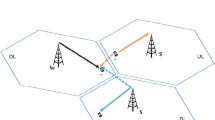Abstract
This paper describes a framework of link capacity analysis for interference mitigation of uplink Orthogonal Frequency Division Multiple Access systems. A Macroscopic Diversity Oriented Resource Allocation (MDORA) is performed via inter-cell coordination based on the location of Mobile Stations (MSs) by exploiting macroscopic diversity in the uplink transmission. In the numerical analysis, the Inter-Cell Interference is derived as a closed form over a multi-cell environment. Subsequent numerical results demonstrate that MDORA offers an efficient inter-cell interference mitigation and a throughput expansion. Moreover, when up-link sectorization is adopted, the MDORA scheme presents a lower inter-cell interference, a reduced outage probability and an improved throughput.












Similar content being viewed by others
References
Amin, M. (1997). Interference mitigation in spread spectrum communication systems using time-frequency distributions. IEEE Transactions on Signal Processing 45, 90–101.
Nokia. (2006). OFDMA Downlink inter-cell interference mitigation, 3GPP, TSG RAN WG1, R1-060291, Denver, USA.
Samsung. (2005). "Flexible fractional frequency reuse approach,” 3GPP, TSG RAN WG1, R1-051341, Seoul, Korea.
Son, H., & Lee, S. (2006). Bandwidth and region division broadband multi-cell networks. IEEE Communications Letters 10(5), 360–362.
Kim, J., Son, H., & Lee, S. (2006). Frequency reuse power allocation for broadband cellular networks. IEICE Transactions on Communications E89-B(2), 531–538.
Yun, S., Park, S. Y., Lee, Y., Alsusa E., & Kang, C. G. (2005). Spectrum efficient region-based resource allocation with fractional loading for FH-OFDMA cellular systems. IEE Electronics Letters 41:752–754.
Katzela, I., & Naghshineh, M. (1996). Channel assignment schemes for cellu mobile telecommunication systems: A comprehensive survey. IEEE Personal Communications 3, 10–31.
Patel, P., Holtzman, J. M. (1994). Analysis of a simple successive interference cancellation scheme in DS/CDMA system, IEEE Journal on Selected Areas - Special Issue on CDMA 12: 796-807.
Liu, Z., Zarki, M. E. (1994). SIR-based call admission control for DSCDMA cellular systems. IEEE Journal on Selected Areas in Communications 12, 638–644.
Kim, I., Shin, B., & Lee, D. J. (2000). SIR-based call admission control by intercell interferenceprediction for DS-CDMA systems. IEEE Communications Letters 4, 29–31.
Lee, S., & Lee, S. (2006). Reverse link capacity analysis over multi-cell environments. IEICE Transactions on Communications E89-B(12): 3479–3482.
Cong, L., & Zhuang, W. (2002). Hybrid TDOA/AOA mobile user location for wideband CDMA cellularsystems. IEEE Transactions on Wireless Communications 1(3), 439–447.
Viterbi, A. J., Viterbi, A. M., Gilhousen, K. S., & Zehavi, E. (1994). Soft handoff extends CDMA cell coverage and increases reverse link capacity. IEEE Journal on Selected Areas in Communications, 12(8), 1281–1287.
Rapport, T. S. (2002) Wireless Communications, 2nd ed. New York:Wiley.
Hanzo, L., Muenster, M., Choi, B., & Keller, T. (2003). OFDM and MC-CDMA for broadband multi-user communications, WLANs and broadcasting. New York: Wiley.
Gilhousen, K. S., Jacobs, I. M., Padovani, R., Viterbi, A. J., Weaver, L. A., & Wheatley, C. E. (1991). On the capacity of a cellular CDMA system. IEEE Transactions on Vehecular Technology 40(2), 303–311.
Jang, J., & Lee, K. (2003). Transmit power adaptation for multiuser OFDM systems. IEEE Journal on Selected Area in Communications 21(2),171–178.
Yates, R. D., & Goodman, D. J. (2005). Probability and shochastic processes. 2nd ed. New Jersey: Wiley.
Kim, J., Son, H., & Lee, S. (2004). Cooperative diversity in wireless networks : Efficient protocols and outage behavior. IEEE Transactions on Information Theory 50(12), 3062–3080.
Chan, G. K. (1992). Effects of sectorization on the spectrum efficiency of cellular radio systems. IEEE Transactions on Vehecular Technology 41.
Jansen, M. G., & Prasad R. (1995). Capacity, throughput, and delay analysis of a cellular DS CDMA system with imperfect power control and imperfect sectorization. IEEE Transactions on Vehecular Technology 44, 217–225.
Son, H., & Lee, S. (2005). Forward-link capacity analysis for MC-CDMA. IEICE Transactions on Communications E88-B: 4094–4096.
Acknowledgments
This research was supported by KT (Korea Telecommunication) and the MKE (The Ministry of Knowledge Economy), Korea, under the ITRC (Information Technology Research Center) support program supervised by the IITA (Institute of Information Technology Assessment) (IITA-2009-C1090-0902-0038).
Author information
Authors and Affiliations
Corresponding author
Rights and permissions
About this article
Cite this article
Lee, S., Lee, S. & Gil, G. Analysis of resource allocation with macroscopic diversity for uplink OFDMA systems. Wireless Netw 16, 1749–1763 (2010). https://doi.org/10.1007/s11276-009-0226-6
Published:
Issue Date:
DOI: https://doi.org/10.1007/s11276-009-0226-6




